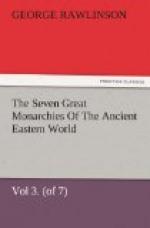CHAPTER III. CHARACTER, MANNERS AND CUSTOMS, ARTS, ETC., OF THE PEOPLE.
“Pugnatrix natio et formidanda.”—Amm. Marc, xxiii. 6.
The ethnic character of the Median people is at the present day scarcely a matter of doubt. The close connection which all history, sacred and profane, establishes between them and the Persians, the evidence of their proper names and of their language, so far as it is known to us, together with the express statements of Herodotus and Strabo, combine to prove that they belonged to that branch of the human family known to us as the Arian or Iranic, a leading subdivision of the great Indo-European race. The tie of a common language, common manners and customs, and to a great extent a common belief, united in ancient times all the dominant tribes of the great plateau, extending even beyond the plateau in one direction to the Jaxartes (Syhun) and in another to the Hyphasis (Sutlej). Persians, Medes, Sagartians, Chorasmians, Bactrians, Sogdians, Hyrcanians, Sarangians, Gandarians, and Sanskritic Indians belonged all to a single stock, differing from one another probably not much more than now differ the various subdivisions of the Teutonic or the Slavonic race. Between the tribes at the two extremities of the Arian territory the divergence was no doubt considerable; but between any two neighboring tribes the difference was probably in most cases exceedingly slight. At any rate this was the case towards the west, where the Medes and Persians, the two principal sections of the Arian body in that quarter, are scarcely distinguishable from one another in any of the features which constitute ethnic type.
The general physical character of the ancient Arian race is best gathered from the sculptures of the Achsemenian kings, which exhibit to us a very noble variety of the human species—a form tall, graceful, and stately; a physiognomy handsome and pleasing, often somewhat resembling the Greek; the forehead high and straight, the nose nearly in the same line, long and well formed, sometimes markedly aquiline, the upper lip short, commonly shaded by a moustache, the chin rounded and generally covered with a curly beard. The hair evidently grew in great plenty, and the race was proud of it. On the top of the head it was worn smooth, but it was drawn back from the forehead and twisted into a row or two of crisp curls, while at the same time it was arranged into a large mass of similar small close ringlets at the back of the head and over the ears. [PLATE IV., Fig. 1.]
[Illustration: PLATE IV.]
Of the Median women we have no representations upon the sculptures; but we are informed by Xenophon that they were remarkable for their stature and their beauty. The same qualities were observable in the women of Persia, as we learn from Plutarch, Ammianus Marcellinus, and others. The Arian races seem in old times to have treated women with a certain chivalry, which allowed the full development of their physical powers, and rendered them specially attractive alike to their own husbands and to the men of other nations.




